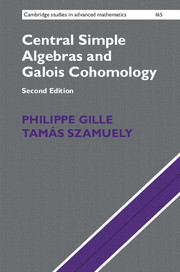Book contents
- Frontmatter
- Contents
- Preface
- 1 Quaternion algebras
- 2 Central simple algebras and Galois descent
- 3 Techniques from group cohomology
- 4 The cohomological Brauer group
- 5 Severi–Brauer varieties
- 6 Residue maps
- 7 Milnor K-theory
- 8 The Merkurjev–Suslin theorem
- 9 Symbols in positive characteristic
- Appendix: a breviary of algebraic geometry
- Bibliography
- Index
9 - Symbols in positive characteristic
Published online by Cambridge University Press: 07 August 2017
- Frontmatter
- Contents
- Preface
- 1 Quaternion algebras
- 2 Central simple algebras and Galois descent
- 3 Techniques from group cohomology
- 4 The cohomological Brauer group
- 5 Severi–Brauer varieties
- 6 Residue maps
- 7 Milnor K-theory
- 8 The Merkurjev–Suslin theorem
- 9 Symbols in positive characteristic
- Appendix: a breviary of algebraic geometry
- Bibliography
- Index
Summary
In the preceding chapters, when working with Galois cohomology groups or K-groups modulo some prime, a standing assumption was that the groups under study were torsion groups prime to the characteristic of the base field. We now remove this restriction. In the first part of the chapter the central result is Teichmüller's theorem, according to which the p-primary torsion subgroup in the Brauer group of a field of characteristic p > 0 is generated by classes of cyclic algebras – a characteristic p ancestor of the Merkurjev–Suslin theorem. We shall give two proofs of this statement: a more classical one due to Hochschild which uses central simple algebras, and a totally different one based on a presentation of the p-torsion in Br (k) via logarithmic differential forms. The key tool here is a famous theorem of Jacobson–Cartier characterizing logarithmic forms. The latter approach leads us to the second main topic of the chapter, namely the study of the differential symbol. This is a p-analogue of the Galois symbol which relates the Milnor K-groups modulo p to a certain group defined using differential forms. We shall prove the Bloch–Gabber–Kato theorem establishing its bijectivity, and obtain as an application the absence of p-torsion in Milnor K-groups of fields of characteristic p, a statement due to Izhboldin.
Teichmüller's result first appeared in the ill-famed journal Deutsche Mathematik (Teichmüller [1]); see also Jacobson [3] for an account of the original proof. The role of derivations and differentials in the theory of central simple algebras was noticed well before the Second World War; today the most important work seems to be that of Jacobson [1]. This line of thought was further pursued in papers by Hochschild [1], [2], and, above all, in the thesis of Cartier [1], which opened the way to a wide range of geometric developments. The original references for the differential symbol are the papers of Kato [2] and Bloch–Kato [1]; they have applied the theory to questions concerning higher-dimensional local fields and p-adic Hodge theory.
The theorems of Teichmüller and Albert
In what follows k will denote a field of characteristic p > 0, and ks will be a fixed separable closure of k.
- Type
- Chapter
- Information
- Central Simple Algebras and Galois Cohomology , pp. 316 - 366Publisher: Cambridge University PressPrint publication year: 2017



